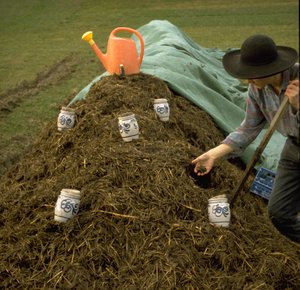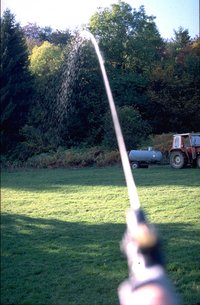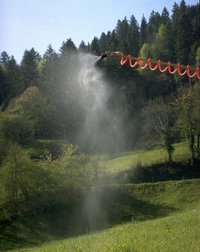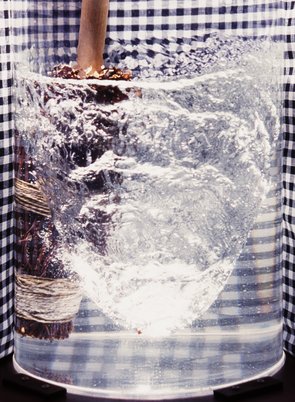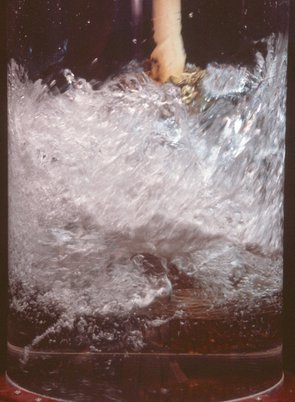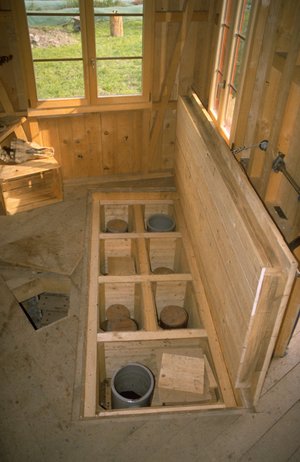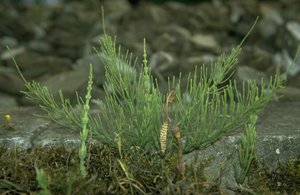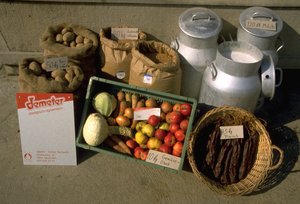Overview:
Agriculture: Why care about?
Today, we can all buy what we need and want, find it in the internet. All is organized, in the hands of specialists. Why should we care about something so a banal like agriculture?
Agriculture, that means cultivating and planting the earth including animal husbandry, is the material basis of the life of everybody of us.
With agriculture, we can produce everything which is necessary for life: Clothing, food etc. In the ideal case, we can do it in a sustainable way. For thousands of years it was the centre of our culture.
It gets more and more governed by criteria which are remote from life or even hostile to life.
The advantage: we can care for other interests.
But we get more and more separated from our material basis of life. More and more heteronomy over vital things. Nature gets overcharged and destroyed, and the quality of foods gets worse.
We threaten the basis of our civilsation and our future.
There is a need for a change.
As consumers we can decide which methods of production we will support with our purchase. Therefore: Conscious purchase! That is not everywhere so easy.
In addition, we can work in a constructive way. Agriculture and gardening today often are limited to certain persons and places. It does not need to be so.
Why agricultural Preparations?
The nature
Pure nature without human influence does not exist anymore. Human development was only possible in combination with shaping the earth. Mankind and earth have developed together.
The mineral subsoil gets broken down by rainwater, carbonic acid, wind, frost etc. Because of the erosion, there is no stability.
Fertile soil ist the product of thousands of years of construction by plants. With their roots, they are holding together the soil, with their leaves, they protect it from overheating, from drying out, from being blown away by the wind and from the heavy impact of falling raindrops.
Plants bring energy and substances into the soil: The photosynthesis in their leaves produces oxygen and also substances for the roots and for root exsudates: carbohydrates, organic acids etc.
These excretions and the remains of dead plants are the basis for the soil life. Fungi and microbes attack with organic acids rocks and extract certain minerals for themselves and for the plants.
The soil life also can get other nutrients from the environment and give them to the plants.
The soil life is making humus from remains of dead plants. Humus enhances the soil’s capacity to store water.
The soil life helps also to make clay. That is a mineral which is not stable, with a great variability of forms, hygroscopic. It can bind minerals and make them available to plants.
Animals, preferably the plant eating ruminants, have a great influence on the flora. Their manure is humus-building.
Fertile soil has a positive influence on the climate. The topsoil and its plants can store and emit water and therefore also warmth. That has a greater influence on the climate than carbon and carbon dioxide.
Man
Already gatherers have an influence on the occurrence of certain plants.
Hunting changes the fauna and therefore also the flora.
Later plants were planted on concentrated fields, and their qualities were changed by selection etc.
Animals were tamed and and bred.
Controlling fire is one of the most important skills of early man: Cooking food, clearing for cultivation and pasture, hunting animals etc. This had great influence on the vegetation.
Biotopes were created: Hedges, fences and walls against wild animals, as protection against wind and sun, warmth was captured, too much water was drained off, fields were irrigated etc. landslides etc. were banned.
Soil cultivation: To loosen soil brings light and air in, it changes the water balance of the soil. Plants can easier root.
With digging stick you can trat single plants.
The first plow was a wooden hook with animal traction. Within it it was possible to make bigger fields which could be cultivated in a uniform way. That can create one-sidedness.
Fertilizing: With the harvest, we take nutriments and forces from the soil. With the times, it could impoverish. We can counteract with fallows, crop rotation and fertilizing by bringing back organic substances. In the ideal case we feed the soil life and it feeds the plants.
In Central Europe, a mixed agriculture evolved: A combination of agriculture and cattle breeding with crop rotations with cereals, root crops, grass and legumes, with own fodder and own manure. And a balanced relation between forests and cleared fields.
Dangers
Fertilizing with single isolated substances can increase yields, but can bring imbalances and can weaken the crops.
There are organisms which re-integrate dead plants and plant parts into soil life. They also can attack weak plants. We call that „plant pests“. To counteract we can bring balance back and strengthen the plants.
Killing the harmful organisms with poisons can bring more imbalance. Regular use of fungicides can eliminate soil fungi. Insecticides can attack bees.
The soil life disappears, the soil gets infertile, and also the climate suffers. Industrialized agriculture and oder human agricultures are harmful for the environment.
Plants which grow under such circumstances often have an altered composition of nutriments which can be disadvantageous for man and animals. Together with industrial processing and refining it can promote civilization diseases.
Some civilisations perished because their agriculture ruined the soil. Often too much forests were cleared. Excessive irrigation can also ruin soils.
What to do?
Organic agriculture and gardening is OK. Also to reduce pollution.
That is not always enough. Soil and environment can need additional support. We can do it with the Preparations.
Rudolf Steiner’s agricultural Preparations
They often are called „Bio-Dynamic Preparations“
We can apply them everywhere. Rudolf Steiner had presented thems 1924 in his Agriculture Course. He made also other propositions which support the effectiveness of these preparations and which are supported by these preparations. cf. below: Bio-Dynamic agriculture
They are tried and tested, but not completely explored.
They contain microbes, hormones and maybe more. They transmit forces which some people call also „informations“. They are spiritual forces which can have multiple effects in the physic reality.
These Preparations have not everywhere the same effects. They can help make deserts and degraded soils fertile, and the can stabilize fertile soils, (German: Ertragsstabilität).
We have two groups of Preparations:
The two Field Spray Preparations: 500: Horn Dung, 501: Horn Silica.
The six Compost Preparations: 502: Yarrow, 503: Chamomile, 504: Nettle, 505: Oak Bark, 506: Dandelion, 507: Valerian.
We work with natural matters and methods which correspond with nature and agriculture, and we deal with the soil, the plants, the animals and the forces by which they are governed.
Some preparation works – their making e.g. – need previous experience. But for the application, specially for the application of the compost preparations and for stirring the field spray preparations for one hour, fairly everybody can help.
Some possible effects of these preparations
Living soil has more and more diversified soil life, better structure, is easier to work, can better manage water and nutrients. The plants have better roots, grow better, are healthier. Also the animals are healthier. The products have better quality, are tastier and more nutritous.
These preparations correspond to a general concept. Spiritual forces act on the matter and support the organizing and vitalizing forces of nature. The soil life, plants and animals get stronger and the quality of the food is enhanced. The effects are multifaceted. The intensions and the additional measures of the users have an influence on them.
We also can diminue the side effects of some risky methods. That may be OK in situations of conversion. But on the long term, it is contradictory: With one hand, you kill soil life, with the other hand, you try to help him up. If we combine these preparations with preparations and methods which are not conform with Rudolf Steiner’s concept, we even can risk problems.
Application of the Compost Preparations
Intentions: Living up the fertilizers: Less losses of nutrients, better conversion and humus formation, increase of the value of the fertilizers.
Applying on fertilizers: They are added to compost, manure and vegetabile and animal liquid manures. About one to two grams per heap or per 10 cubic metres.
Photo: Everywhere where is a pot the corresponding preparation will be introduced.
At the end, just before covering (here: with the green fleece), the Valerian Preparation will be diluted with warm water and sprinkled over the manure heap.
P.S.:Composting is vital. It often is an underestimated and neglected action. It brings back to life what is fallen out of it. It means keeping the earth alive, bringing organic carbon and other resources to there were they belong.
For beginners: If you want to start working with these preparations, making compost can be a first step. dding the six preparations to a compost heap is easy work. If you have two heaps, you can prepare only one and compare the effects.
As field sprays: The Compost Preparations also can be applied on fields etc. as Compound Preparations like Maria Thun’s Barrel Compost, CPP, etc.
Intentions: Enlivening the soil and stimulating plant growth from below.
Application time: Rudolf Steiner had proposed to apply it at sowing time. It also is applied at other occasions, when a meadow is mowed or grazed or at any time where the growth has to be stimulated or the soil has to be enlivened.
How to apply: First, it is stirred one hour with water and then normally it is sprayed as big droplets on the soil.
Photo: Rock crystal cavern deep in the mountain at Gerstenegg near Guttannen/BE (access: www.grimselwelt.ch)
Manufacture: Quartz, silica or orthoclase is finely groud and filled in cowhorns and ripened over summer in the earth.
N.B. This is the moment when the preparation gets the cosmic forces. They have not to be „stirred in“ later, as already erronously was told.
Intentions: Has a relation to light and warmth. Supplements Horn Dung Preparation. Stimulates plant growth in its different states of development. Enhanced photosynthesis means also more roots exsudates for the „soil food web“.
Application time: It is sprayed on the growing and ripening plants.
How to apply: First, it also is stirred one hour with water and then it is sprayed as a fine mist on the plants.
Stirring the Field Spray Preparations Horn Dung and Horn Silica
This is done just before their application
They are intensively mixed with water by stirring them strongly:
- Turn quickly in one direction at the periphery of the vessel until a deep crater is formed. (photo at left)
- Then change quickly the direction so that it bubbles and seethes. (photo at right)
- and continue turning etc. for one full hour without interruption.
In a transparent vessel you can see what happens in the water. No preparation is added. It could disturb the water.
Videos: Stirring of the Preparations ...
This stirring of the Field Spray Preparations
Whilst stirring, we transform our will into action and connect the spiritual forces in the preparations with the earthly forces. That only can be done by mankind, with an individual „I“.
That is why people should stir, not machines, and as much of us as possible.
Rudolf Steiner had proposed to stir together with guests, at sunday afternoons, with the necessary entertainment. So stirring is not only for insiders.
We can look at it as a work or as a ritualistic ceremony.
If producers have not enough staff, stirring often is done by machines or simplified.
Man kann es als eine Arbeit betrachten, aber auch als eine kultische Handlung.
Oft haben Produktionsbetriebe zu wenig Personal. Deshalb wird oft mit Maschinen gerührt oder das Rühren wird vereinfacht.
Links
Instructions for stirring:
- Stirring vortex poster (PDF) - Shows the movements of the water under different stirring methods.
- Presentation of the brochure about stirring
Description of different ways of handstirring:
- Stirring poster (PDF)
- Exposition - Pictures about the exposition of stirring equipment
Tools for the application:
About the application and the making of Rudolf Steiner’s preparations
Storage of the Preparations
You do not need any storing installation if you use Preparations just after digging them out. You alos do not need any if you use Preparations which you get from elsewhere as soon as possible.
If you let the Preparations in the soil until you use them, you risk that the soil life will eliminate them.
Rudolf Steiner had proposed to store the Horn Manure in boxes which are lined with peat moss.
Storage of Cow Manure and the Compost Preparations
They are stored in peat moss. The safest but also the most costly way to avaoid direct contact between the Preparations and the peat are boxes with double walls and covers, with the peat moss between the two walls. You put the Preparations into glasses or stoneware vessels and put them into the box.
It seems that most preparations are more effective. Experience shows that. But that is not clearly demonstrated in scientific tests yet. So other factors could be of importance, too.
You can build such boxes by yourself. Or buy at www.biodynamie-services.fr
In my book, you will find instructions for such constructions and also detailed descriptions of other methods for storing.
Storage of Horn Silica
Rudolf Steiner said that sunlight could be good. Normally this preparation is stored in transparent glass on a sunny place, a windowsill e.g. Take care: Cats can push them down.
P.S.: Substitute for peat moss?
Because of overexploitation, peat moss is in question. But we need very few and it lasts for years, even decennies.
There are people who make research about formative forces with the method of imagination. They say that coconut coir is better. Maybe. It always is a question where these imaginations com from and how to interprete them. I do not know another research method yeat which confirms these researches and also none which follows the influence of the strorage method until the quality of the products we eat.
Some indications about quantities
Water
In the home garden: Take a vessel within which you can stir easily (10 - 30 liter total volume), fill it at half with water and distribute the stirred liquid evenly as possible on the area.
In agriculture, for larger areas: Take about 20 - 30 liters per hectare. For intensive cultivation, as in truck gardening, you can take more. On extensive surfaces, as on alps, I already have reduced to five liters per hectare.
We take water of high quality. Clean rainwater is preferred.
Preparations
Horn Dung Preparation: One standard for large areas is 100 grams per hectare. After some years of successfull application, the quantity can be reduced. Larger quantities sometimes can be useful, specially if the quality of the preparation is not optimal.
In a home garden: 25 - 30 grams can be OK.
Horn Silica Preparation: A standard is two grams per hectare.
For home gardens: A pinch can be OK.
Compost Preparations: What you can pick with three fingers, one to two grams of each preparation.
General
Some people give very exact recommendations, others work with sensitivity. The recommendations vary. I give here only some ideas about the quantities.
It is better to spray more often than to apply large quantities of preparations at once.
The quantity of water, stirring method and stirring tool, the size and form of the vessel are to get in tune with each other and with the stirring persons (body size, force, stamina etc.).
P.S.: Horsetail
Rudolf Steiner recommended it as a prevention against fungus disease.
We boil the herb, dilute the decotion and spray it as a preventive measure on the soil. (Or in cases of emergency also on the plants.)
It is not everywhere regarded as of the same importance.
The Bio-Dynamic Method of agriculture
The Bio-Dynamic Method of agriculture
In principle, these preparations can be applied everywhere. But they work better with corresponding additional measures.
In 1924, Rudolf Steiner had given a course of eight lectures on agriculture.* Its basis is the anthroposophy which he inaugurated.
* Steiner, Rudolf: Landwirtschaftlicher Kurs. Geisteswissenschaftliche Grundlagen zum Gedeihen der Landwirtschaft. Rudolf Steiner Verlag Basel. Bound version: GA Nr. 327, 8th edition 1999 / Paperback Nr. 640, 2005.
English translations:
- George Adams Kaufmann: Agriculture Course. Goetheanum Dornach, CH 1929.
- Catherine E. Creeger and Malcolm Gardner: Spiritual Foundations for the Renewal of Agriculture. BDFGA Kimberton/USA 1993.
This course is the basis for the Bio-Dynamic method of agriculture and gardening. This method is tried and tested allover the world.
A farm is regarded as an individuality, as a living organism, which should ideally be productive out of itself.
Cosmic and earthly forces work together and should be brought into balance.
That means
- Closed circuits: The food of the farm animals is grown on the own fields which are fertilized with manure oft the own animals. etc.
- Rotation of crops which include many different plants, and/or mixed cultivations.
- Adapted plants and animals.
- No chemical-synthetic fertilizers, pesticides and other risky technologies.
- Moderate use of technical aids, of not renewable resources etc.
- The application of Rudolf Steiner’s preparations which are also called „Bio-Dynamic Preparations“.
Demeter®
That is the registered trademark for the commercialization of Bio-Dynamic products. The owners of this mark are Bio-Dynamic organizations allover the world.
Production and processing are adapted to the political and economic conditions of today, regulated and controlled.
N.B.: Thanks to this brand we know what we buy and what we support, even if we do not know the producers personally.
Rudolf Steiner’s preparations and the additional measurescan be applied without the certification, therefore also in family gardens, ornamental gardens, parks, forests etc.
Daily production of a mixed Bio-Dynamic farm
Near Berne in Switzerland, with agriculture and dairy cows on 13 hectares:
An illustration for the farm as a productive organism:
126 kg milk
4.38 kg meat: cattle and lamb
4.2 kg cereals: Wheat and rye
49 kg potatoes
10 kg fruits and vegetables.
When the cereals are consumed as wholemeal, 110 persons get 2400 kilocalories (Kcal) per day.
Purchases per year: 1’000 liter diesel, 200 liter petrol, 1’400 kg rock dust, 100 kg cattle salt, 30 kg soda (for cleaning the milking tools), 15 - 20’000 kWh electricity for light and motors.
(Albert Remund 1992 in Stappung 2017 p.27)
My calculation: The farm produces food with 264’000 Kcal per day. Purchase: 70’000 Kcal/day.
Netto-production: 194’000 Kcal/day.
This farm needs 120 square meters of arable land for the survival of one person.
N.B: The house is heated with wood from the own forest.
Processing and marketing needs short ways. That also is a positive fact.








